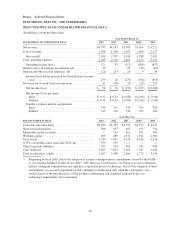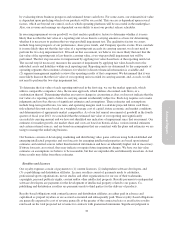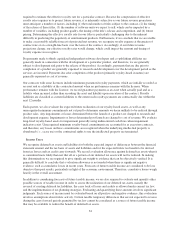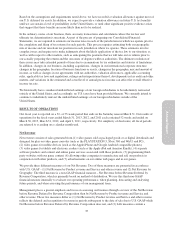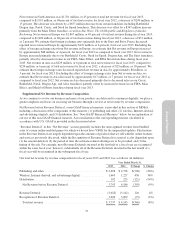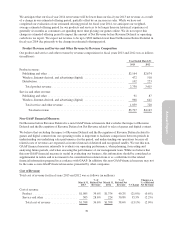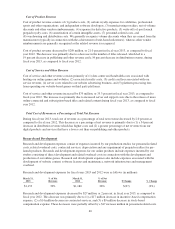Electronic Arts 2013 Annual Report Download - page 117
Download and view the complete annual report
Please find page 117 of the 2013 Electronic Arts annual report below. You can navigate through the pages in the report by either clicking on the pages listed below, or by using the keyword search tool below to find specific information within the annual report.
Annual Report
by evaluating future business prospects and estimated future cash flows. For some assets, our estimated fair value
is dependent upon predicting which of our products will be successful. This success is dependent upon several
factors, which are beyond our control, such as which operating platforms will be successful in the marketplace.
Also, our revenue and earnings are dependent on our ability to meet our product release schedules.
In assessing impairment on our goodwill, we first analyze qualitative factors to determine whether it is more
likely than not that the fair value of a reporting unit is less than its carrying amount as a basis for determining
whether it is necessary to perform the two-step goodwill impairment test. The qualitative factors we assess
include long-term prospects of our performance, share price trends, and Company specific events. If we conclude
it is more likely than not that the fair value of a reporting unit exceeds its carrying amount, we do not need to
perform the two-step impairment test. If based on that assessment, we believe it is more likely than not that the
fair value of the reporting unit is less than its carrying value, a two-step goodwill impairment test will be
performed. The first step measures for impairment by applying fair value-based tests at the reporting unit level.
The second step (if necessary) measures the amount of impairment by applying fair value-based tests to the
individual assets and liabilities within each reporting unit. Reporting units are determined by the components of
operating segments that constitute a business for which (1) discrete financial information is available and
(2) segment management regularly reviews the operating results of that component. We determined that it was
more likely than not that the fair value of our reporting unit exceeded its carrying amount, and, as such, we did
not need to perform the two-step impairment test.
To determine the fair value of each reporting unit used in the first step, we use the market approach, which
utilizes comparable companies’ data, the income approach, which utilizes discounted cash flows, or a
combination thereof. Determining whether an event or change in circumstances does or does not indicate that the
fair value of a reporting unit is below its carrying amount is inherently subjective. Each step requires us to make
judgments and involves the use of significant estimates and assumptions. These estimates and assumptions
include long-term growth rates, tax rates, and operating margins used to calculate projected future cash flows,
risk-adjusted discount rates based on a weighted average cost of capital, future economic and market conditions
and determination of appropriate market comparables. As of our last annual assessment of goodwill in the fourth
quarter of fiscal year 2013, we concluded that the estimated fair value of our reporting unit significantly
exceeded its carrying amount and we have not identified any indicators of impairment since that assessment. Our
estimates for market growth, our market share and costs are based on historical data, various internal estimates
and certain external sources, and are based on assumptions that are consistent with the plans and estimates we are
using to manage the underlying business.
Our business consists of developing, marketing and distributing video game software using both established and
emerging intellectual properties and our forecasts for emerging intellectual properties are based upon internal
estimates and external sources rather than historical information and have an inherently higher risk of inaccuracy.
If future forecasts are revised, they may indicate or require future impairment charges. We base our fair value
estimates on assumptions we believe to be reasonable, but that are unpredictable and inherently uncertain. Actual
future results may differ from those estimates.
Royalties and Licenses
Our royalty expenses consist of payments to (1) content licensors, (2) independent software developers, and
(3) co-publishing and distribution affiliates. License royalties consist of payments made to celebrities,
professional sports organizations, movie studios and other organizations for our use of their trademarks,
copyrights, personal publicity rights, content and/or other intellectual property. Royalty payments to independent
software developers are payments for the development of intellectual property related to our games. Co-
publishing and distribution royalties are payments made to third parties for the delivery of products.
Royalty-based obligations with content licensors and distribution affiliates are either paid in advance and
capitalized as prepaid royalties or are accrued as incurred and subsequently paid. These royalty-based obligations
are generally expensed to cost of revenue generally at the greater of the contractual rate or an effective royalty
rate based on the total projected net revenue for contracts with guaranteed minimums. Significant judgment is
33





